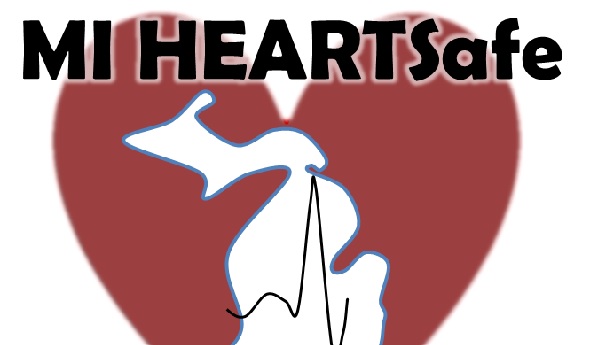
105 Schools Recognized As HEARTSafe
October 19, 2016
The Michigan Departments of Health and Human Services (MDHHS), and Education (MDE); American Heart Association (AHA); Michigan High School Athletic Association (MHSAA); and Michigan Alliance for Prevention of Sudden Cardiac Death of the Young (MAP-SCDY) have awarded 105 schools in Michigan with the MI HEARTSafe School designation which recognizes schools that are prepared to respond to cardiac emergencies.
“Many sudden cardiac deaths that claim the lives of children and young adults could be prevented through screening, detection, and treatment,” said Dr. Eden Wells, chief medical executive of MDHHS. “Appropriate medical response within three to five minutes is crucial for increasing the chance of survival, which is why I’m pleased to see so many of our schools taking vital measures to prepare and address this health issue.”
In order for a school to receive a MI HEARTSafe School designation, it must perform at least one cardiac emergency response drill per year, have a written medical emergency response plan and team, have current CPR/AED certification of at least 10 percent of staff, 100 percent of head varsity coaches, and 50 percent of P.E. staff; have accessible, properly maintained and inspected AEDs with signs identifying their location; and ensure pre-participation sports screening of all student athletes using the current physical and history form endorsed by the Michigan High School Athletic Association.
“We are so proud to support Michigan’s HEARTSafe schools,” said State Superintendent Brian Whiston. “Ensuring schools are prepared for sudden cardiac emergencies through planning, training, and life-saving AEDs is an important part of having safer learning environments for students, staff, and the community.”
Between 2003 and 2012 in Michigan, there were 2,590 young individuals between 1 and 39 years of age who died of sudden cardiac death. Of those, 214 were between 5 and 19 years of age. This is the third year of the MI HEARTSafe Schools program in Michigan. In the first two years of the initiative, 162 schools were previously designated as MI HEARTSafe Schools and prepared to help reduce the number of sudden cardiac deaths in our youth.
Public Act 12 of 2014 requires all schools (grades kindergarten to 12) to have a cardiac emergency response plan in place. This MI HEARTSafe School designation recognizes the 267 school buildings that have taken steps above and beyond to prepare to respond in the event of a cardiac emergency, and is awarded for a period of three years. Click for the list of designated schools.
Schools that meet all of the requirements will be able to apply for the MI HEARTSafe School designation each year. Click for information about the MI HEARTSafe Schools program.

MHSAA Sportsmanship Summits to be Presented for First Time Since 2019
By
Geoff Kimmerly
MHSAA.com senior editor
September 28, 2022
The Michigan High School Athletic Association’s annual Sportsmanship Summit series will return this fall to be conducted for the first time since 2019, again focusing on sportsmanship both on and off the field of play.
The MHSAA has conducted Sportsmanship Summits across Michigan for more than 20 years, and this year’s series kicks off Nov. 7 in Marquette and finishes Nov. 16 in Ypsilanti.
MHSAA staff, with assistance from school administrators and the MHSAA Student Advisory Council, conduct Sportsmanship Summits. More than 800 students are expected to take part in the four workshops, where they will discuss the line that separates good from bad sportsmanship, both as athletes during competition and when it comes to cheering at athletic events.
Workshop sessions will feature hands-on activities including one session developed and instructed by members of the Student Advisory Council. At the end of the day the delegation from each participating school will meet to develop a school sportsmanship campaign. Breakouts at each Summit also provide a great opportunity for student sections to learn about appropriate student section behavior. There will be information for the veteran student sections, as well as guides for schools that want to start their own organized student sections for the first time.
“Winning is great, but good sportsmanship helps develop habits that can be used well beyond the playing field,” said MHSAA assistant director Andy Frushour, the lead Sportsmanship Summits presenter. “A lively student section can create a fun and exciting atmosphere at games, but we want to make sure students don’t take this a step too far. The Summits are a great way to learn from other schools around the state.”
Sessions will take place at the following:
• Marquette – Nov. 7 – NMU Northern Center – 9 a.m. - 1:30 p.m.
• Saginaw – Nov. 9 – SVSU Conference Center – 9 a.m. - 1:30 p.m.
• Grand Rapids – Nov. 14 – Sheraton Grand Rapids Airport Hotel – 9 a.m. - 1:30 p.m.
• Ypsilanti – Nov. 16 – Ann Arbor Marriott Ypsilanti at Eagle Crest – 9 a.m. - 1:30 p.m.
Registration at each site is limited to the first 225 students and administrators. Schools are welcome to bring as many as 10 total representatives, including two administrators. For additional registration information, contact Andy Frushour at the MHSAA office – [email protected] or (517) 332-5046. Registration information also is available on the MHSAA Website.

